Bitcoin Gains Focus as Ethereum's Appeal Fades, Analyst Observes
Analyst Nicholas Merten predicts Bitcoin's dominance over Ethereum, citing stagnation and lack of innovation in the ETH ecosystem.
 Brian
Brian
Source: Carbon Chain Value
On February 5, ARK Invest, founded by Cathie Wood, released its annual "Big Ideas" report. The report introduces the current status and important future trends of the accelerated development of future technologies from 11 sections, including artificial intelligence, Ai agents, Bitcoin, public chains, robots, energy storage, and autonomous driving. The full content totals 148 pages. Among them, ARK Invest predicts in the Bitcoin section of the report that Bitcoin is expected to reach $1.5 million by 2030. Ai agents will bring epoch-making changes in the future.
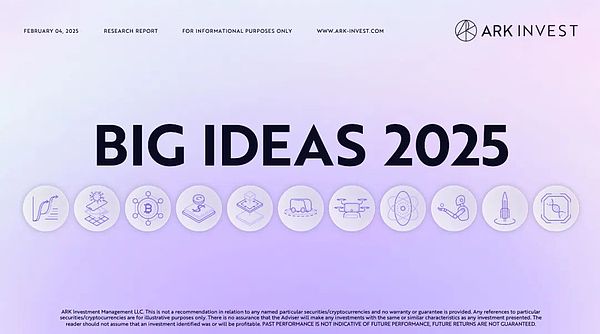
ARK Invest said that this year's report proposed 11 "big ideas" to show the great changes taking place today. Our research shows that these "big ideas" are expected to significantly increase productivity, completely change all walks of life, and create long-term investment opportunities.
Carbon Chain Value has picked out five "big ideas": Bitcoin, artificial intelligence/Ai agents, stablecoins, and public chain expansion for readers' reference and learning. The overall feeling given by the content of this year's report is that it focuses a lot on AI and Crypto. For example, Bitcoin, public chains, stablecoins, DeFi, DEX, smart contracts, digital wallets, etc. have corresponding introductions and predictions. If readers are interested in the report, they can go to the official website of ARK Invest to download the full version of the report and read the rest of the content.
The following are excerpts from the report on the five "big ideas":
Bitcoin hits a record high in 2024
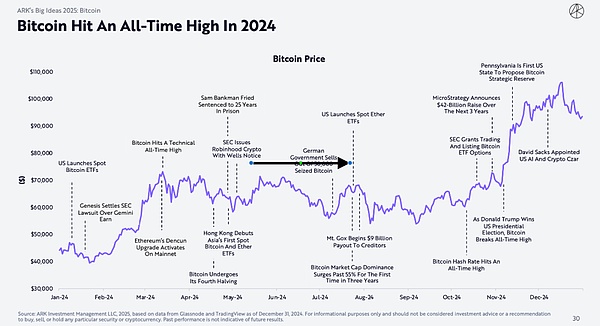
Bitcoin spot ETF is the most successful ETF in history
On its first day of listing, the Bitcoin spot ETF attracted more than $4 billion in inflows, setting a record since the ETF was listed, exceeding the "2012 Bitcoin ETF Market Report" released by the U.S. Securities and Exchange Commission. In November 2004, the gold ETF received $1.2 billion in inflows in its first month. The inflows of the Bitcoin spot ETF far exceed the first-month inflows of about 6,000 ETFs issued in the past 30 years.
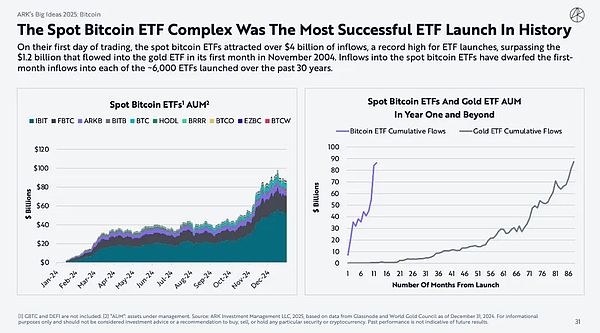
Bitcoin's inflation rate drops below gold's long-term supply growth after its 4th halving
After the 4th "halving" in the history of Bitcoin's supply growth, the annual growth rate dropped from about 1.8% to about 0.9%. Halving is critical to its design, highlighting Bitcoin's predictable monetary policy and its role as a scarce asset.

Bitcoin's annual volatility has fallen to a record low, but its risk-adjusted return is still better than most major asset classes
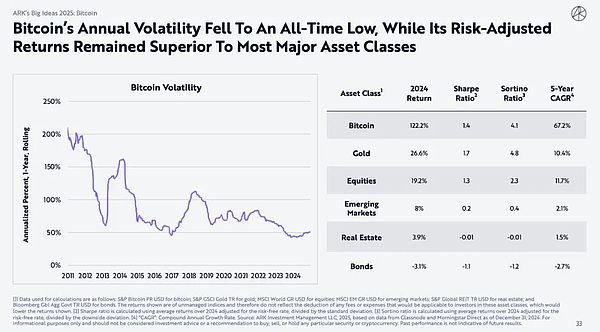
Despite a sharp drop in miner revenue after halving, Bitcoin's hash rate hits a record high
Despite a 50% reduction in Bitcoin miner revenue due to halving, its hash rate hits a record high. In other words, miners' long-term confidence in Bitcoin remains strong.

Transactions Soar, Thanks to Runes
Bitcoin’s daily transaction count hits a record high, thanks to the launch of the Runes protocol. The Runes protocol facilitates the creation of fungible tokens directly on the Bitcoin blockchain.
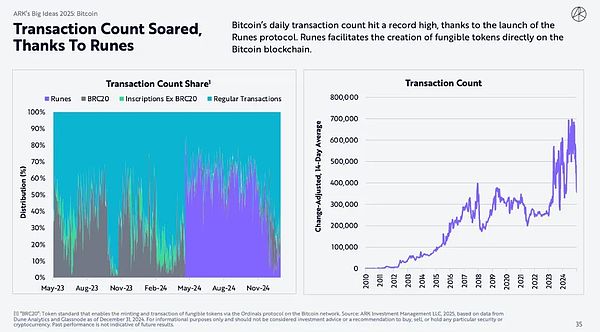
Bitcoin Absorbs Significant Selling Pressure in 2024
In January 2024, the German government seized 50,000 bitcoins linked to a cyber piracy group. Six months later, it sold those bitcoins. The market successfully absorbed the supply, and then the price of Bitcoin rose from $53,000 to $68,000. In addition, around mid-year, the long-awaited Mt. Gox1 creditor repayment process distributed more than 109,000 bitcoins, eliminating its biggest overhang.
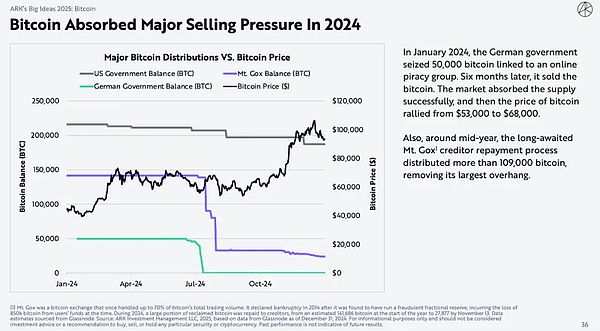
More and more public companies hold Bitcoin
Currently, 74 public companies hold Bitcoin on their balance sheets. Over the past year, the value on corporate balance sheets has quintupled, from $11 billion to $55 billion in 2023.
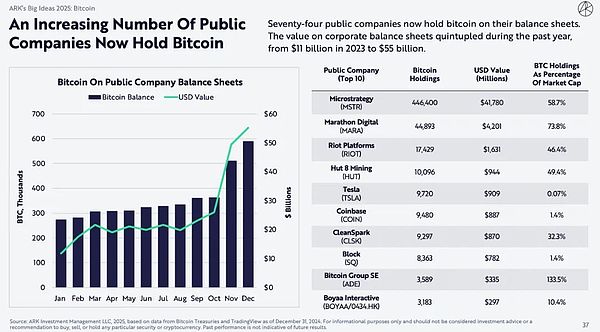
Bitcoin’s Total Cost Basis Hits New High in 2024
Bitcoin’s realized capitalization, or cost basis, grows 86% in 2024 as its average acquisition cost hits a record high of $40,980 per bitcoin, totaling $811.7 billion.
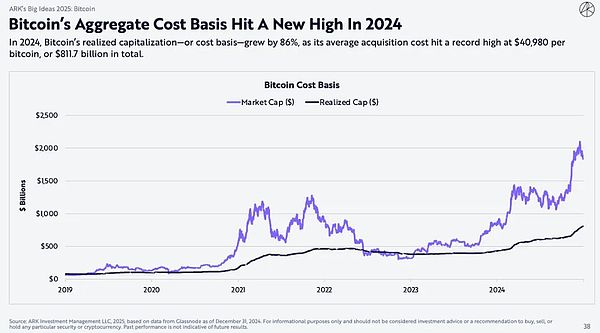
Bitcoin’s transaction velocity and holding behavior highlight its role as a store of value
Bitcoin’s transaction velocity falls to a 14-year low in 2024 as supply held for three years or longer reaches an all-time high.
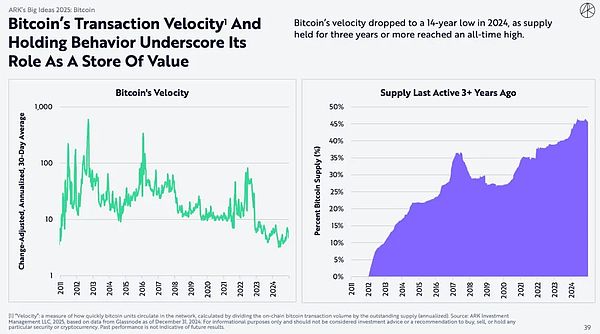
Bitcoin is on track to achieve our 2030 price target of $1.5 million/BTC
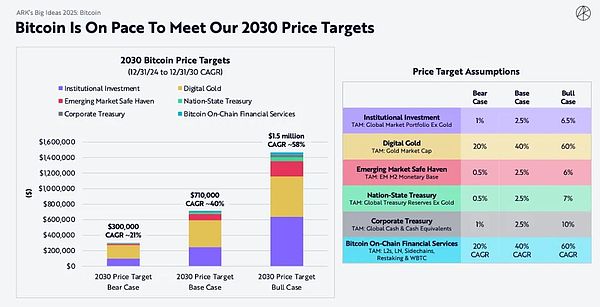
Mainly due to improvements in AI system architecture, AI computing performance per dollar is expected to increase by more than 1,000 times by 2030. By then, we expect computing performance to double 64 times compared to when integrated circuits were introduced.
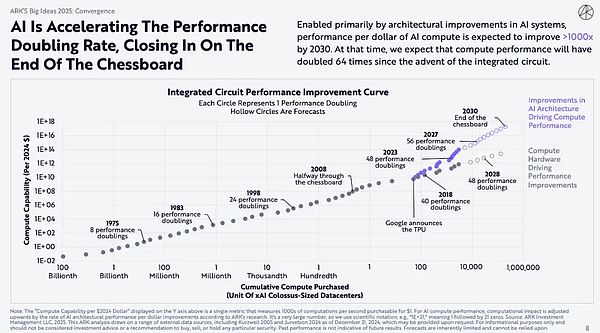
Advances in AI will unlock huge market opportunities
As AI continues to accelerate, self-driving taxis will continue to become more common, drug development time and costs will drop significantly, and AI agents will be able to autonomously solve software engineering challenges, monitor and modify systems around the clock.

Technology revolutions are accelerating convergence
ARK measures the extent to which technology is acting as a catalyst between innovation platforms. The degree of convergence between them is increasing, and network density has increased by 30% in the past year.
AI is critical to unlocking the value of precision medicine and multi-omics technologies. Smart contract ecosystems are becoming testbeds where autonomous AI agents can be paid for improving their capabilities. Next-generation cloud energy demand is driving the timeline for distributed energy generation.
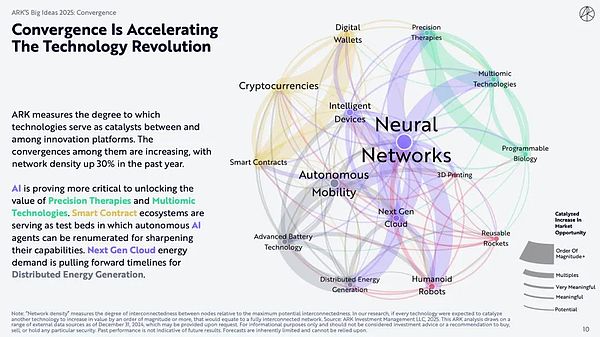
The accelerated development of neural networks is accelerating the development of all other disruptive technologies
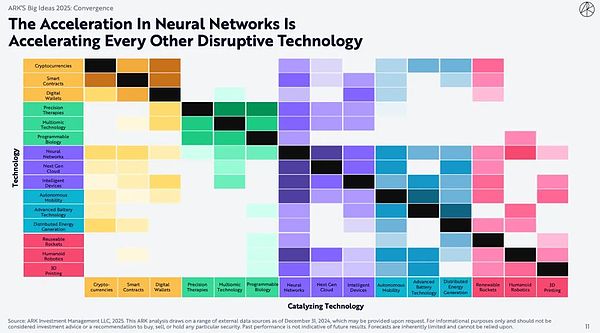
Advances in artificial intelligence, energy storage, and public blockchains are critical to the pace of technological progress
Among disruptive technologies, neural networks are the most important catalyst.
According to our research, advances in neural networks will increase the value of six of the other 14 technologies by at least an order of magnitude, creating a huge market expansion for next-generation cloud, smart devices, autonomous mobility, humanoid robots, precision medicine, and multi-omics technologies. The technological revolution led by AI could lead to a massive increase in productivity and a step-change in economic growth.
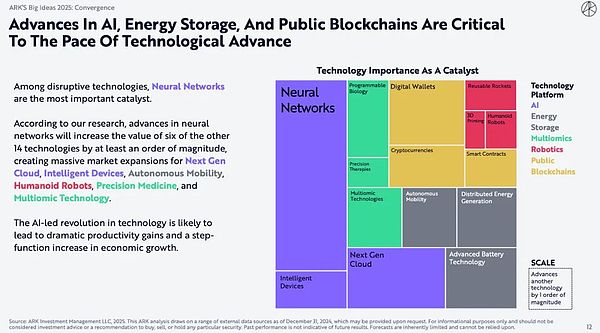
Technology inflection points should bring about GDP inflection points
Structural changes in the underlying macroeconomic growth rate are the rule, not the exception.
After 100,000 years of economic stagnation, innovation, especially the advent of writing, enabled empires to connect continents, quadrupling real growth rates by 1000 AD.
Agricultural innovations enabled population density to increase and the labor force to specialize, doubling annual growth rates to 0.3% by 1500.
In the 400 years before 1900, annual GDP growth doubled again to 0.6% as the Enlightenment and the Industrial Revolution swept the world.
The Second Industrial Revolution, marked by electrification, cars, and telephones, ushered in the modern era, quintupling average growth rates to 3% over the past 125 years.
Technological breakthroughs in artificial intelligence, autonomous driving, and biomimetic robots are likely to boost productivity again, achieving another growth step in the next 5 to 10 years.
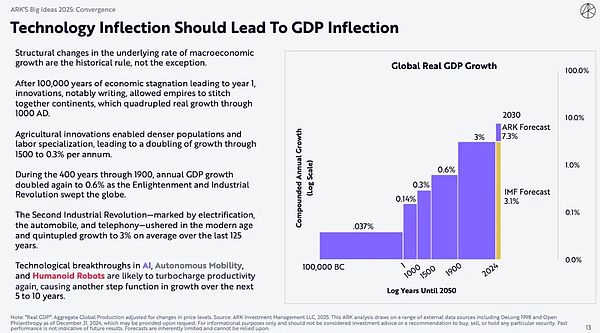
Disruptive innovation may gradually dominate the market
Disruptive innovation may account for more than two-thirds of the global stock market, with a compound growth rate of 38% by 2030.
In the field of innovation, market value may exceed the so-called Mag 6. Non-innovative companies may begin to shrink as technological deflation related to innovation threatens profit margins and competitiveness, even in the context of rapid macroeconomic growth.
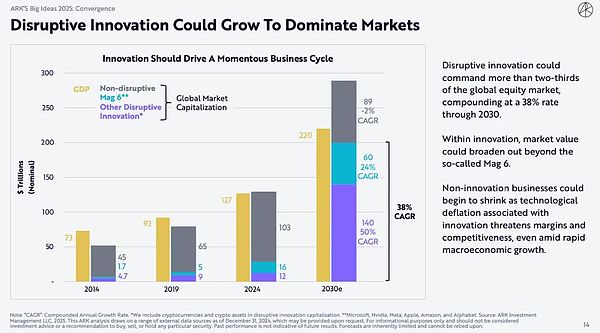
What are AI Agents?
AI Agents are expected to accelerate the adoption of digital applications and bring about a revolutionary change in the field of human-computer interaction.
AI Agents:
Understand intent through natural language and use reasoning and appropriate context to plan. Use tools to take actions to achieve intent. Improve through iteration and continuous learning. Smarter models that use more tools to complete higher-value tasks.
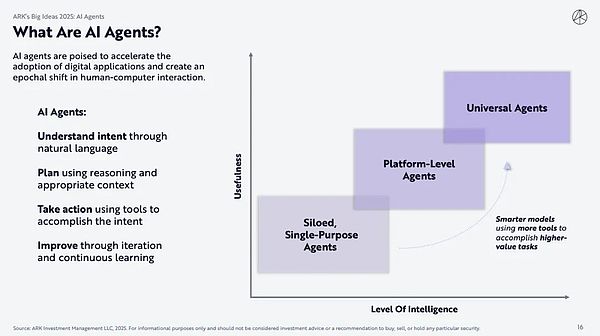
AI is accelerating the adoption of hardware and software
OpenAI's revenue may exceed $10 billion in 2025, and its monetization rate is faster than that of social media companies in the past decade. If the adoption of ChatGPT is an indicator, AI should drive rapid demand for a range of new technologies.
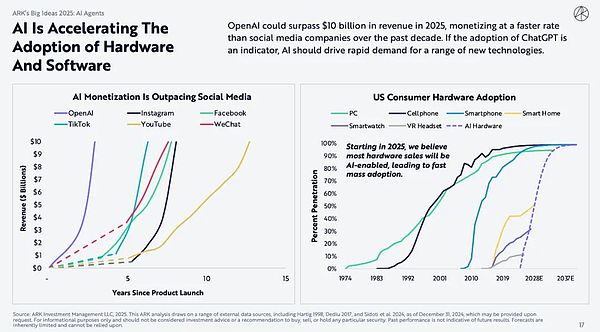
AI Agents Will Transform Consumer Search and Discovery
AI Agents are embedded in the operating system of consumer hardware, enabling consumers to delegate all discovery and research to AI, saving a lot of time. Curated AI results will make digital ad impressions more contextual.
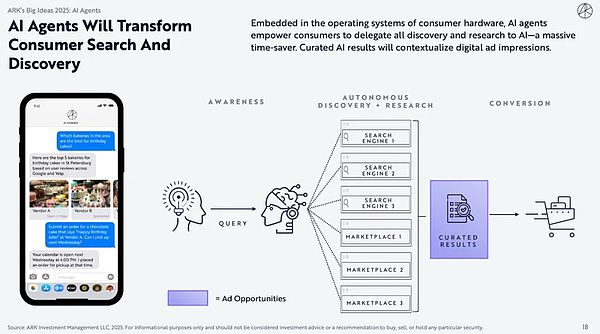
Digital Advertising Revenue to Share the Largest Share in 2030
If search shifts to personal AI Agents, AI advertising revenue could surge. By 2030, we believe AI advertising revenue will account for more than 54% of the $1.1 trillion digital advertising market.

AI Shopping Could Account for 25% of Global Addressable Online Sales by 2030
The increasing use of AI Agents in consumer shopping should streamline product discovery, personalization, and purchase.
ARK research suggests that AI Agents could facilitate nearly $9 trillion in total online spending worldwide by 2030.
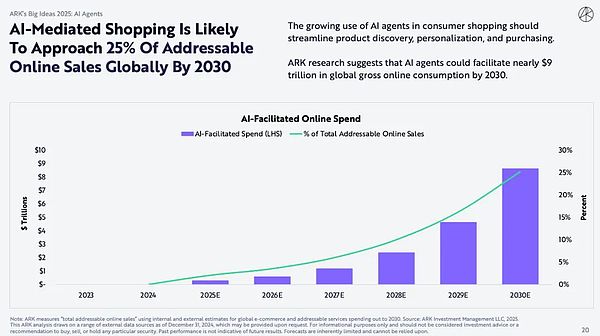
Digital Wallets Expected to Continue Expanding Their Share of E-Commerce
ARK research suggests that digital wallets powered by AI purchasing agents (replacing payment methods such as credit and debit cards) could account for 72% of all e-commerce transactions by 2030.
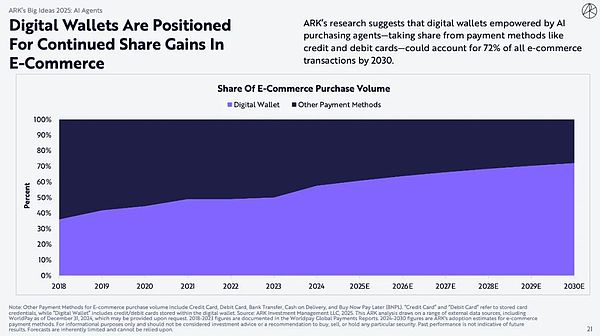
Digital wallets are consolidating financial services and e-commerce
The market currently values leading digital wallet platforms such as Block, Robinhood, and SoFi at $1,800 per user based on consumer-facing operations.
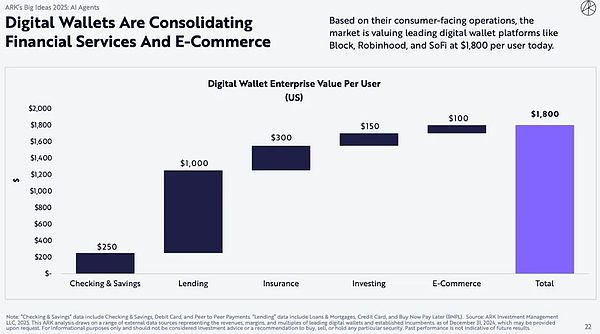
Digital wallet procurement agents may become the core of the shopping journey
Agent lead generation should drive digital wallets upstream to capture market share in global e-commerce and digital consumption. “One-click checkout” should give way to “one-click purchase.”
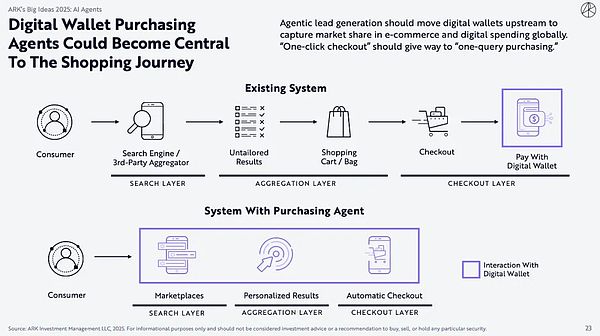
Sourcing Agents Should Increase Enterprise Value of Digital Wallets, Particularly in E-Commerce
Depending on lead generation rates, AI Agents could generate $40 billion to $200 billion in global revenue for digital wallet platforms in 2030 (ARK’s base and bullish cases, respectively).
AI Agents could add $50 to $200 in enterprise value (EV) per user of digital wallets in the U.S. by 2030.
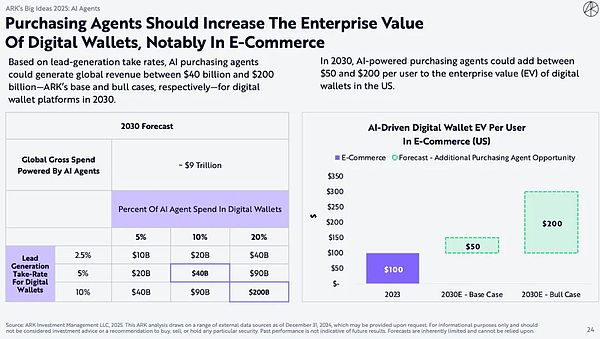
In the Enterprise, AI Agents Will Improve Productivity Through Software
Companies deploying AI Agents should be able to increase unit volume with the same workforce and/or optimize their workforce for higher value activities. As AI advances, AI Agents may handle a higher proportion of workloads and complete higher-value tasks independently.
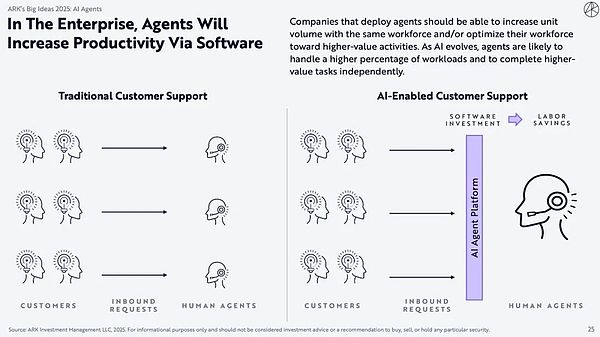
AI cost reduction will significantly affect the AI Agents economy
New products from OpenAI and Salesforce are complementing human customer service representatives in a cost-effective way. Even if the fixed cost per conversation is $1, as long as AI Agents can handle 35% of customer service inquiries, it can save companies a lot of money. AI Agents should also reduce onboarding and recruitment costs and seat-based software costs, while being easier to scale than humans.
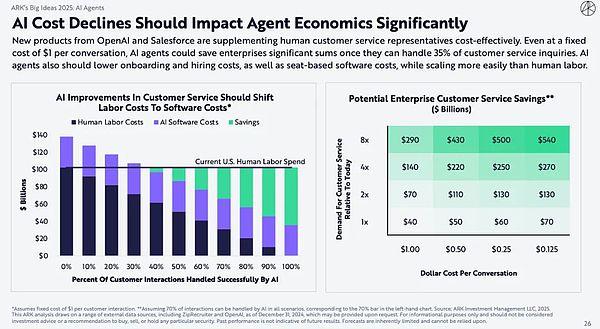
AI is reshaping the software value chain
The coding skills of AI Agents are rapidly improving, accelerating the software development cycle. As the cost of creating software falls, software production should accelerate and influence enterprise "build vs. buy" decisions, displacing legacy software companies that are less able to adapt. As client software proliferates, growth at all layers of the software stack should accelerate, even as share shifts to the platform layer.

AI will enhance knowledge work
AI is driving a Cambrian explosion in the software industry. By 2030, we expect the amount of software deployed per knowledge worker to grow significantly as enterprises invest in productivity solutions. Depending on the rate of adoption, global software spending could accelerate from an average of 14% per year over the past decade to an average of 18% to 48% per year.

As one of the fastest growing areas in digital assets, stablecoins will exceed Mastercard and Visa in terms of transaction volume in 2024
Despite a two-year bear market and a market value drop of more than 70%, the growth of stablecoins has not been interrupted. In 2024, the annualized transaction volume of stablecoins reached 15.6 trillion US dollars, which is about 119% and 200% of Visa and Mastercard respectively. The monthly transaction volume reached 110 million, accounting for about 0.41% and 0.72% of the transaction volume processed by Visa and Mastercard. In other words, the value of stablecoins per transaction is much higher than that of Visa and Mastercard.

Stablecoin transaction volume hits record high in December 2024
Solana, Tron, Ethereum and Base are the main public chains driving the growth of stablecoin transaction volume in 2024. A new record was set in December 2024, with daily transaction volume reaching US$270 billion and monthly transaction volume reaching US$2.7 trillion, highlighting the rapid growth of the industry.
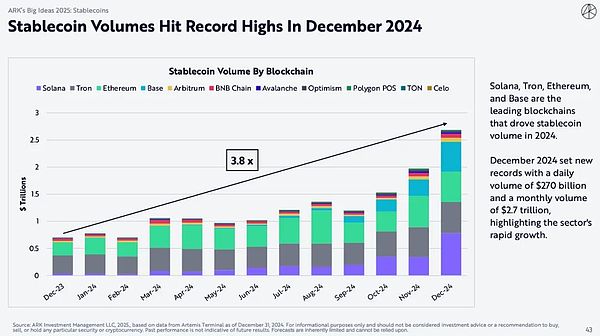
Ethena Labs tokenizes popular base transactions and accumulates US$6 billion in 12 months
Innovation in the stablecoin field is booming, and Ethena Labs is one of the fastest growing projects. Despite criticism for its novel design, the project has captured a large share of the non-fiat-backed stablecoin market and has become a major competitor in this $200 billion space.
Ethena Labs saw $6 billion in total value locked in its first 12 months. By tokenizing delta-neutral positions, Ethena Labs can offer yields of up to 20%-30%, depending on market conditions. In a bear market, yields could turn negative. Ethena Labs already holds 10% of total Ethereum holdings and is expanding into Solana and Bitcoin delta-neutral trading.

After a drop in 2023, stablecoin supply and the number of active stablecoin addresses hit an all-time high in 2024
UDST (Tether) continues to dominate the stablecoin space, followed by USDC (Circle). Together, they account for 90% of the total supply. Stablecoins are “multi-chain” and have penetrated almost all major layer 1 blockchains. Stablecoin supply is $203 billion, accounting for about 0.97% of the U.S. M2 money supply. In December, active stablecoin addresses reached 23 million, a record high. Tron is the leading network measured by monthly active addresses, favored by emerging markets for its low transaction fees.
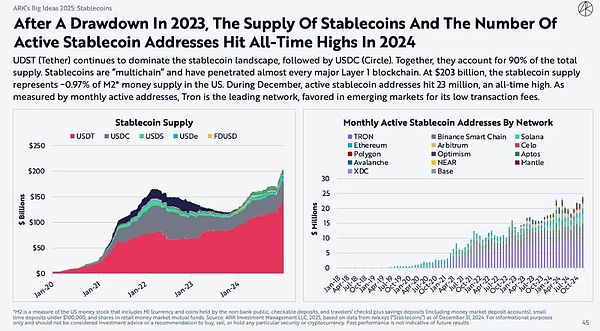
As some countries gradually abandon the dollar, digital assets are moving closer to the dollar
Digital assets are undergoing “stablecoinization” and “dollarization”, while China and Japan sold record amounts of U.S. Treasuries, Saudi Arabia ended the 45-year petrodollar agreement, and the BRICS reduced their reliance on dollar payments by bypassing the SWIFT network. Historically, Bitcoin and Ethereum have been bridges into the digital asset ecosystem. However, over the past two years, stablecoins have taken their place and now account for 35% to 50% of on-chain transaction volume.
USD-pegged stablecoins dominate, accounting for more than 98% of supply, followed by gold-backed stablecoins and euro-backed stablecoins, which account for about 1% and about 0.5%, respectively. ARK's research suggests that the market will continue to expand and include stablecoins backed by Asian currencies.
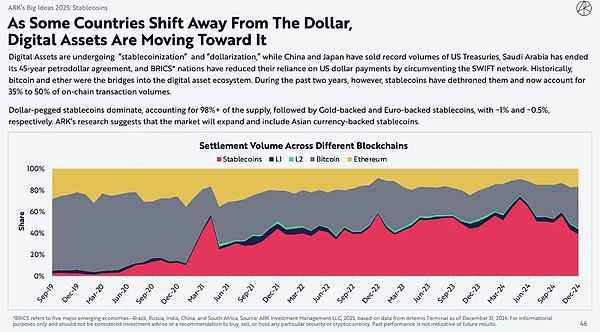
Stablecoins are attracting retail investor interest due to lower costs and higher efficiency of Layer 2
Retail investors have flocked to Layer 2 for cheaper and more convenient stablecoin transactions, increasing the market share of blockchains such as Arbitrum, Base, and Optimism. Meanwhile, whales and institutions continue to operate on Ethereum's base layer. Transactions below $100 dominate on Base and Optimism, while transactions above $100 dominate on Ethereum’s base layer.
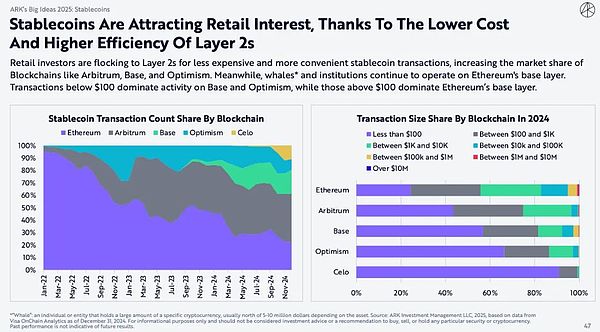
Peer-to-peer transactions and personal wallet storage dominate stablecoin use cases
Externally owned accounts (EOA) — standard Ethereum addresses used for peer-to-peer (P2P) transactions and storage — account for 60% of USDC usage, while centralized exchanges account for 11%, Ethereum Layer2 cross-chain bridges account for 7%, and decentralized exchanges (DEX) and money markets account for 1.7% each.
As DeFi usage surges in the coming years, DEXs, Bridges, and money markets are likely to take back market share from P2P.
While usage of lending markets, DEXs, and Bridges fluctuates with market cycles, P2P trading and storage are more resilient because there is greater product-market fit beyond trading.
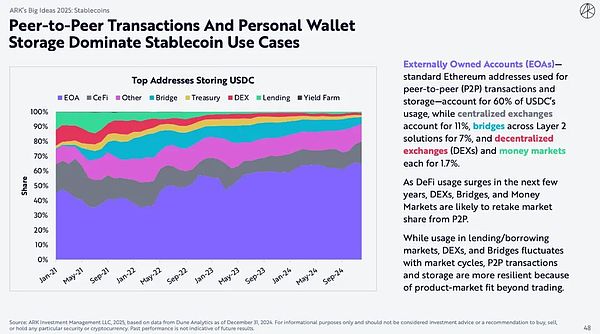
Four major stablecoin issuers dominate revenue generated by digital assets
Tether, which has fewer than 200 employees, reported $5.2 billion in profits in the first half of 2024, including unrealized gains on USDT, the rest of its products and services, and digital assets—clearly one of the most capital-efficient businesses in history.
Tether (USDT) and Circle (USDC) account for 60% of revenue generated by the top five networks and applications. In the second half of 2024, stablecoins USDT, USDC, DAI/USDS, and USDE generated a total of $3.35 billion in revenue, or $6.7 billion on an annualized basis.
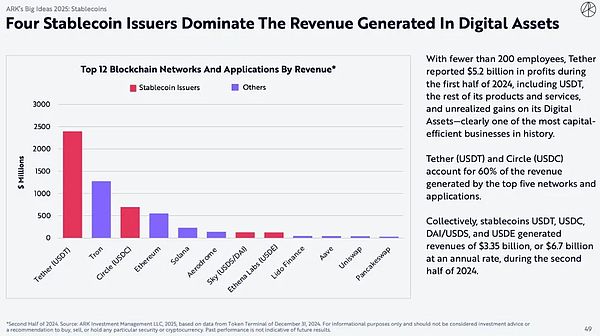
Tether's financial performance is amazing, both in absolute and relative terms
Tether has fewer than 200 employees, while JPMorgan Chase and Berkshire Hathaway both have more than 300,000 employees. In the first half of 2024, the only institutions in the S&P Financial Select Industry Index with net income exceeding Tether are Berkshire Hathaway, JPMorgan Chase, Bank of America, and Wells Fargo.
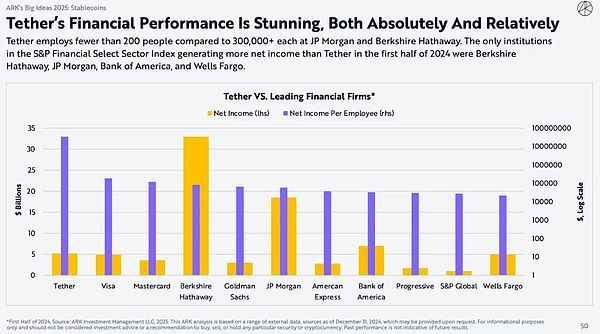
To balance "de-dollarization", stablecoins are increasing demand for U.S. Treasuries as collateral
In a world moving toward deglobalization and de-dollarization, stablecoins may drive stable demand for U.S. Treasuries. As of December 2024, Tether and Circle have collectively become the 20th largest holder of U.S. Treasuries.
Individuals and companies in populous emerging markets such as Brazil, Nigeria, Turkey, Indonesia, and India are adopting stablecoins as a store of value, means of payment, and cross-border currency. Stablecoins could become one of the most efficient ways to export dollars.
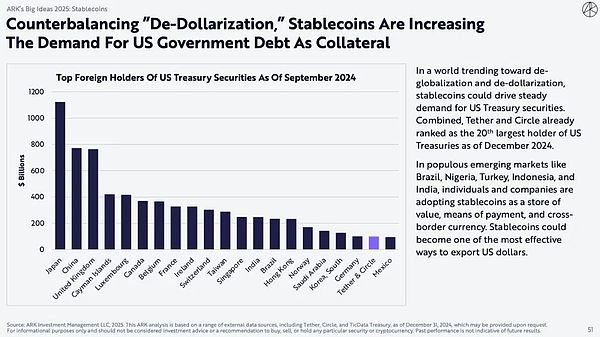
Stablecoin issuers are passing on risk-free rates to users
Circle and Tether have been generating billions of dollars in revenue from Treasury bills and other securities used as collateral for their stablecoins. However, in 2024, in response to competition and demand, stablecoins operating outside the United States began to pass on a significant portion of their interest income to users.
Circle and Tether are unlikely to follow this trend unless absolutely necessary. Although still small, yield-generating stablecoins are the fastest growing category in the stablecoin market.
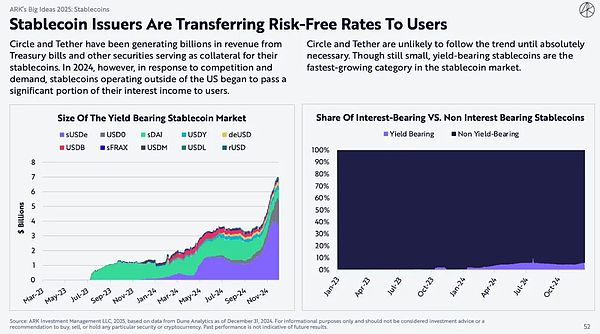
By 2030, stablecoins could increase from 0.17% to 0.9% of the global M2 supply of fiat currencies
Currently, stablecoins are $203 billion, accounting for 0.17% of the global M2 supply. By 2030, stablecoins could increase to $1.4 trillion and 0.9%, respectively.
By then, stablecoins will become the 13th largest currency in circulation in the world, second only to Spain and ahead of the Netherlands.
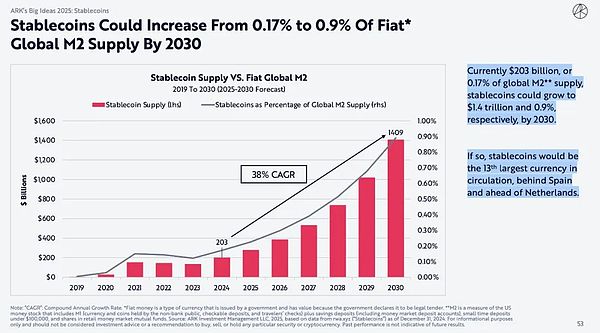
Explore the field of smart contracts
As the digital asset field becomes more and more complex, smart contracts are driving innovation in more and more industries. The ecosystem is rapidly evolving to meet diverse and dynamic needs - from user-centric applications such as games and SocialFi, to advanced financial instruments such as derivatives and structured products, to decentralized infrastructure networks that support wireless connectivity and energy storage.

Applications seeking lower fees and higher efficiency are either deployed on Solana’s high-throughput Layer 1 or Ethereum’s Layer 2
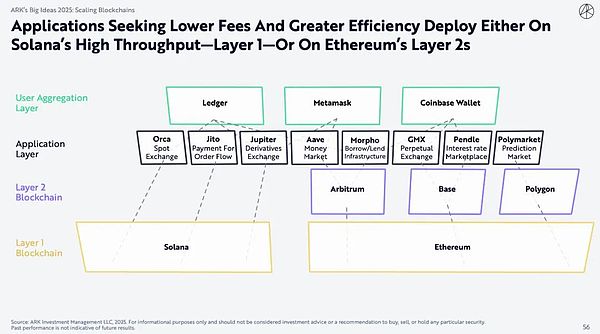
Ethereum’s EIP 4844 technical upgrade reduces transaction costs by 10 times, spurring adoption
One of Ethereum’s most important technical upgrades to date, EIP 4844, impacted the Layer 2 network by enabling faster and cheaper transactions.
Before the EIP 4844 upgrade, the average transaction fee on Ethereum’s Layer 2 was about $0.50. Now, users only pay about $0.05.
EIP 4844 is the first milestone in the roadmap and should enable a 250-1250x increase in transactions per second (TPS) from about 400 today to 100,000-500,000.
More than 200 layer 2 projects have been launched, with others in the works.

Lower transaction costs lead to a surge in layer 2 activity, pulling users away from Ethereum’s base layer
Layer 2 accounts for 85% of daily active addresses transacting in the Ethereum ecosystem. Activity on layer 2 has increased Ethereum’s daily transaction volume by 400% from 3 million to 15 million by 2024.
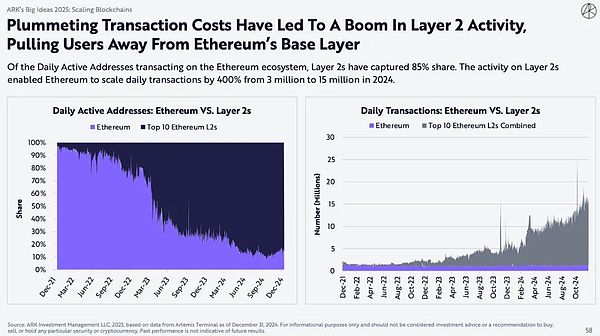
Base is the fastest growing Ethereum layer 2 blockchain
Within a year of launch, Base has surpassed all other Ethereum layer 2 solutions in growth and market share. In 2024, Base accounts for 46% of active users and generates 63% of fees in Ethereum layer 2. With $15 billion in total locked value and more than 300 applications deployed, Base has made a significant contribution to Coinbase's cash flow.
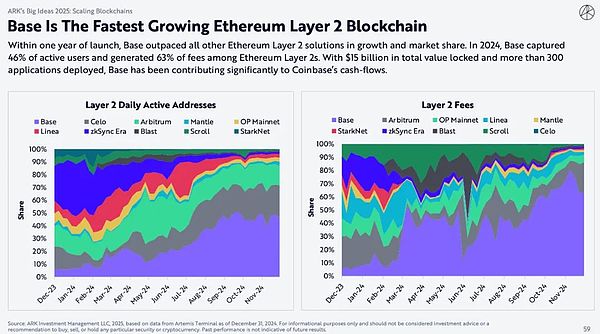
Despite the migration to layer 2, Ethereum's base layer still dominates high-value storage and settlement
Institutions, high-value users, and whales primarily settle transactions on the Ethereum base layer. The unit economics of Ethereum’s base layer, measured by total value locked (TVL) and decentralized exchange (DEX) volume per user, are unmatched.
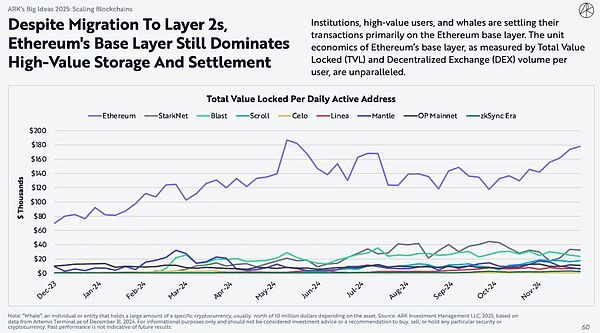
As DeFi soars to all-time highs, DEXs challenge CEXs in spot and derivatives trading
When Binance reached a settlement with the U.S. Securities and Exchange Commission (SEC) for more than $4 billion and its CEO stepped down in 2024, centralized exchanges (CEXs) lost some share to decentralized exchanges (DEXs). From January to the peak, spot and derivative DeFi trading volumes nearly doubled, increasing market share from 8% and 3% to 14% and 8%, respectively, setting new all-time highs. During the same period, Binance’s market share among centralized exchanges fell from 62% to 35%.
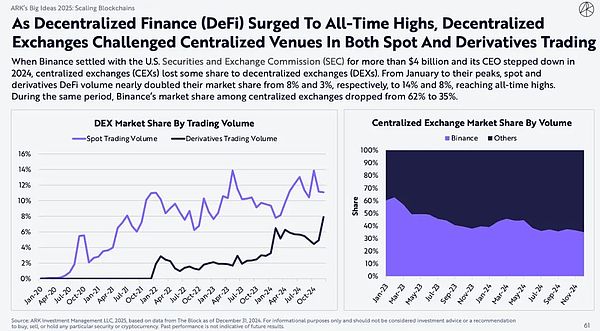
Smart contract-driven exchanges are 5-10 times more efficient than centralized exchanges
Decentralized exchanges (DEXs) such as Uniswap, Aerodrome, and Raydium leverage the efficiency of small, agile teams to develop and maintain core protocol infrastructure. DEXs have a huge efficiency advantage over centralized exchanges, with only one-tenth the number of employees. With about 9,000 employees, Binance leads the centralized exchange space in terms of employee headcount.

Liquidity staking and re-staking protocols are the preferred method for staking and re-staking ETH
Liquidity staking and re-staking have become the preferred method for generating Ether yields. Due to their yield characteristics, liquidity, and accessibility, they now account for 40% of ETH staked. The need to re-stake ETH to increase yield has spawned re-staking platforms, which now account for about 5.5 million Ether staked, accounting for 17% of staked ETH.
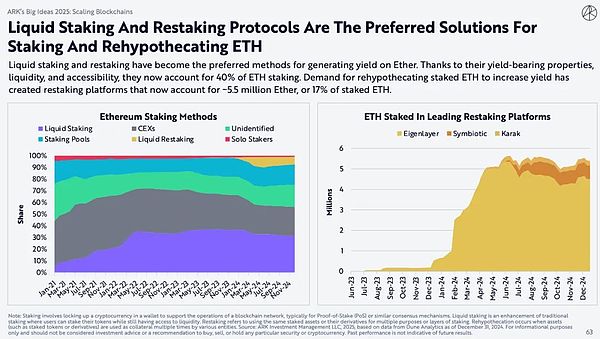
Led by Polymarket, prediction markets become the breakthrough consumer application in 2024
In 2024, Polymarket accumulated more than 3 million users and reached $1.2 billion in monthly trading volume, with 70% of activity related to elections and politics. After a brief decline after the election, the number of daily unique users has recovered to 50,000 and trading volume is on the rise, with sports being the most important category.
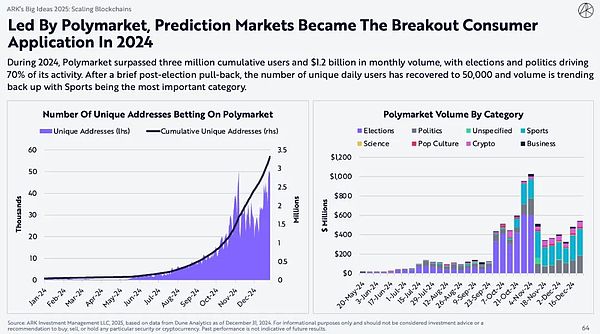
Solana has higher throughput than Ethereum, thanks to its high-performance design and strategic trade-offs
Ethereum’s throughput has more than doubled to around 200 transactions per second (TPS), thanks to Layer 2 and EIP 4844 upgrades. Still, Solana is performing well, with an average throughput of around 800 TPS.
Solana’s success is based on a series of trade-offs, including more expensive hardware requirements and parallel transaction processing. Solana’s new Firedancer client can increase its throughput to hundreds of thousands of TPS.
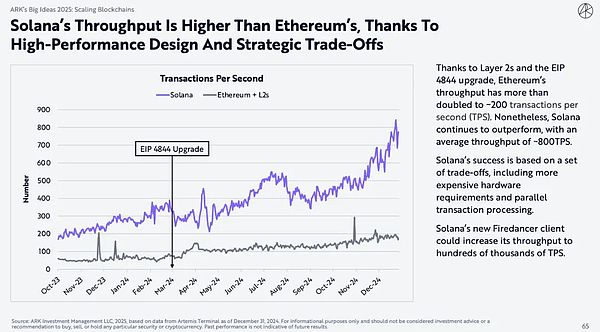
Solana Gains Market Share on Multiple Metrics Due to Massive Retail Adoption
After hitting a bear market low of $8 in 2023, Solana has seen a sharp turnaround relative to other Layer 1s. Daily active users, revenue, number of transactions, and total locked value (TVL) have all hit all-time highs or increased by an order of magnitude. Solana is the only Layer 1 that competes with Ethereum and Bitcoin on metrics such as daily active addresses and revenue.
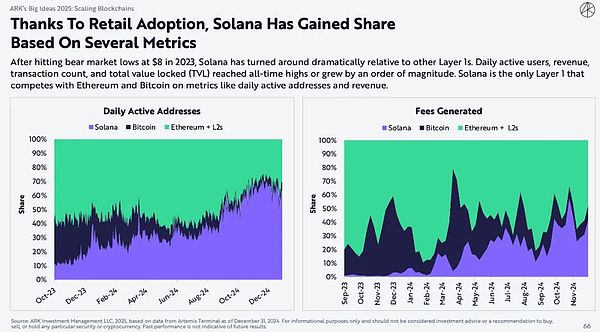
Solana and Base Lead in Developer Adoption and Market Share
Of the 39,139 new crypto developers added in 2024, Solana leads with 7,625 developers, surpassing the Ethereum mainnet. Base has 4,287 developers, ranking sixth, surpassing Arbitrum and Starknet to become the leading Layer 2 solution on Ethereum.
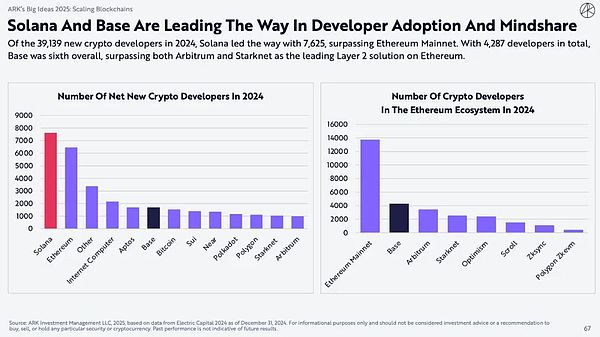
Analyst Nicholas Merten predicts Bitcoin's dominance over Ethereum, citing stagnation and lack of innovation in the ETH ecosystem.
 Brian
BrianWall Street's foray into Bitcoin ETFs, led by firms like Goldman Sachs and JP Morgan, poses risks that contradict Bitcoin's foundational principles.
 Brian
BrianBetter Markets CEO criticizes SEC's potential approval of Bitcoin ETF, citing fraud risks and possible investor harm
 Kikyo
KikyoAn unknown entity transferred 26.91 BTC to Satoshi Nakamoto's address, stirring intrigue and speculation in the crypto community.
 Brian
BrianDCG clears $700 million debt to Genesis, showcasing financial resilience and strategic foresight in the volatile crypto market.
 Kikyo
KikyoXi Jinping's "high-quality development" mantra for China remains enigmatic, prompting global speculation about its practical implications.
 Alex
AlexForward's no-code blockchain toolkit, akin to WordPress, simplifies Web3 access and innovation.
 Brian
BrianSurge and subsequent decrease in EVM chain transactions, primarily involving inscriptions, raises questions about their future in the blockchain landscape.
 Kikyo
KikyoRussia leads BRICS in a strategic push for increased IMF influence, signifying a shift in global financial power dynamics.
 Alex
AlexHashKey Exchange in Hong Kong overhauls operations to comply with new global Travel Rule, reflecting a shift towards tighter regulatory oversight in the cryptocurrency sector.
 Brian
Brian